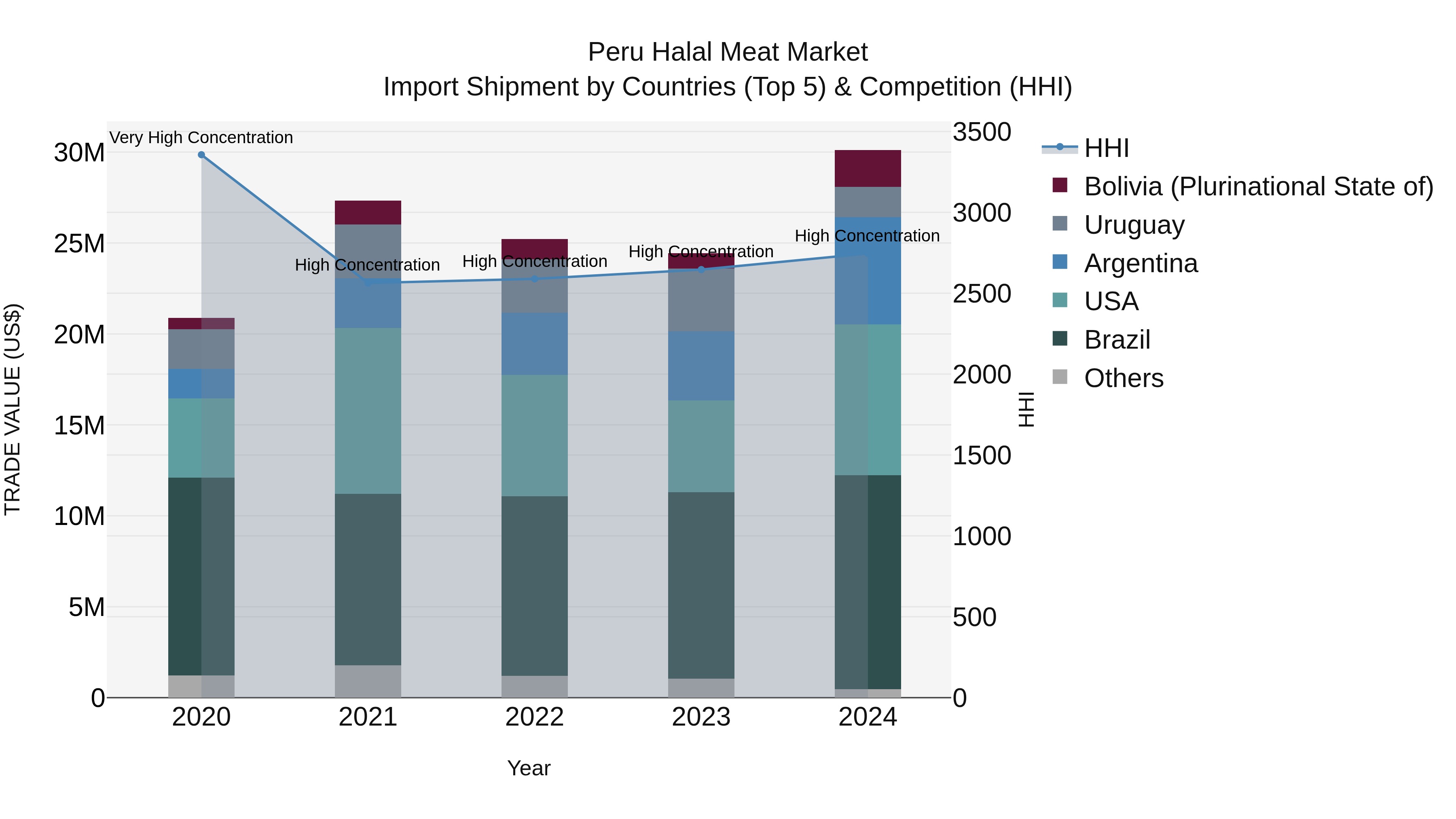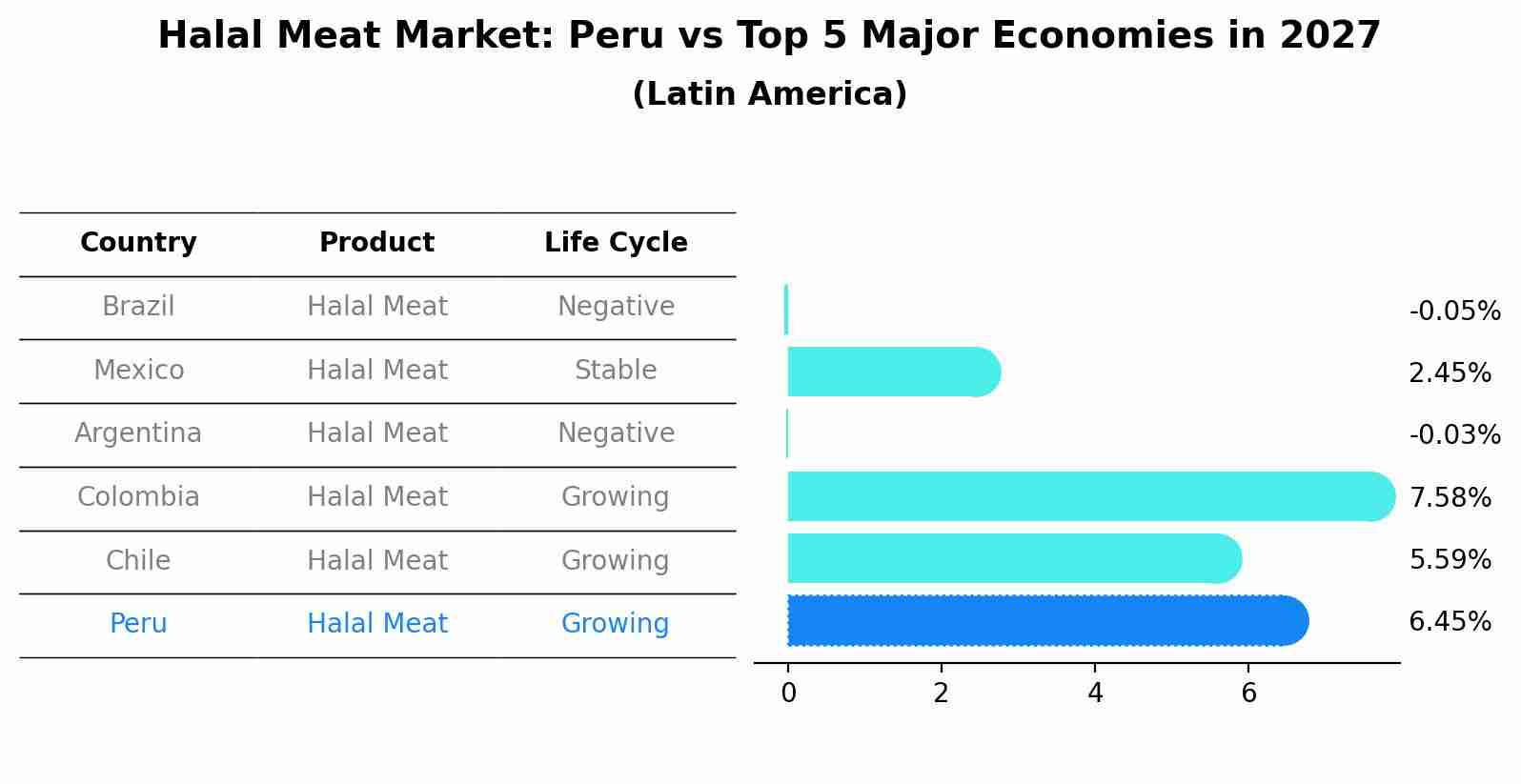Peru Halal Meat Market (2025-2031) Outlook | Companies, Industry, Value, Size, Share, Revenue, Analysis, Trends, Forecast & Growth
| Product Code: ETC293526 | Publication Date: Aug 2022 | Updated Date: Nov 2025 | Product Type: Market Research Report | |
| Publisher: 6Wresearch | Author: Summon Dutta | No. of Pages: 75 | No. of Figures: 35 | No. of Tables: 20 |
Peru Halal Meat Market Top 5 Importing Countries and Market Competition (HHI) Analysis
Peru`s halal meat import market continued to show strong growth in 2024, with top exporters including Brazil, USA, Argentina, Bolivia, and Uruguay. The high Herfindahl-Hirschman Index (HHI) indicates a concentrated market, while the impressive Compound Annual Growth Rate (CAGR) of 9.57% from 2020 to 2024 reflects sustained expansion. The notable growth rate of 23.13% from 2023 to 2024 signals increasing demand for halal meat in Peru, presenting opportunities for exporters to capitalize on this trend.

Halal Meat Market: Peru vs Top 5 Major Economies in 2027 (Latin America)
By 2027, the Halal Meat market in Peru is anticipated to reach a growth rate of 6.45%, as part of an increasingly competitive Latin America region, where Brazil remains at the forefront, supported by Mexico, Argentina, Colombia and Chile, driving innovations and market adoption across sectors.

Peru Halal Meat Market Overview
The Peru Halal Meat Market is experiencing significant growth driven by the increasing Muslim population in the country and rising awareness about halal dietary practices. The market offers a variety of halal meat products, including beef, chicken, lamb, and goat, which adhere to Islamic dietary laws. Domestic producers and importers play a key role in supplying halal meat to meet the demand of both the Muslim community and non-Muslim consumers who are increasingly seeking halal-certified products for quality and safety assurance. The market is characterized by stringent halal certification processes to ensure compliance with halal standards, providing transparency and trust to consumers. As the Muslim population continues to grow in Peru, the halal meat market is expected to expand further, presenting opportunities for both local and international players to cater to this niche segment.
Peru Halal Meat Market Trends
The Peru Halal meat market is experiencing steady growth due to the increasing demand for halal-certified products among the Muslim population in the country. Halal meat is perceived as healthier and more ethically produced, driving its popularity among a broader consumer base beyond the Muslim community. The market is witnessing a shift towards more transparent and traceable supply chains, with consumers showing a preference for products with clear halal certifications. Additionally, there is a growing interest in premium and value-added halal meat products, such as ready-to-eat meals and processed meats. As the awareness and recognition of halal certification continue to rise in Peru, the market is expected to expand further, presenting opportunities for local and international halal meat producers to cater to the evolving preferences of consumers.
Peru Halal Meat Market Challenges
In the Peru Halal Meat Market, several challenges are faced, including limited awareness and understanding of halal certification among consumers and businesses, leading to lower demand for halal products. Additionally, the lack of standardized halal certification processes and regulatory frameworks in Peru can create confusion and hinder market growth. Importing halal meat can also be costly due to transportation expenses and tariffs, impacting the overall affordability and competitiveness of halal products in the market. Furthermore, the presence of counterfeit halal products poses a threat to consumer trust and the reputation of genuine halal producers. Addressing these challenges through education, regulatory improvements, and collaboration within the industry can help unlock the growth potential of the Peru Halal Meat Market.
Peru Halal Meat Market Investment Opportunities
The Peru Halal Meat Market presents promising investment opportunities due to the country`s growing Muslim population and increasing demand for halal-certified products. Investors can consider opportunities in halal meat processing facilities, distribution networks, and retail outlets to cater to the needs of this niche market segment. Additionally, exporting halal meat products to other countries with Muslim populations can also be a lucrative venture. Collaborating with local suppliers and producers to ensure compliance with halal standards can enhance market competitiveness. With the rising awareness and preference for halal-certified products among Muslim consumers, investing in the Peru Halal Meat Market has the potential for sustainable growth and profitability.
Peru Halal Meat Market Government Policy
The government of Peru has implemented various policies to regulate and promote the halal meat market within the country. These policies include establishing guidelines for halal certification to ensure compliance with Islamic dietary laws, supporting the development of infrastructure for halal meat production and export, and conducting regular inspections to maintain quality standards. Additionally, the government has facilitated partnerships with international halal certification bodies to enhance market access for Peruvian halal meat products in Muslim-majority countries. Overall, these policies aim to boost the growth of the halal meat industry in Peru, increase exports, and position the country as a reliable supplier of high-quality halal products in the global market.
Peru Halal Meat Market Future Outlook
The future outlook for the Peru Halal Meat Market appears promising due to several factors. The increasing Muslim population in Peru, combined with a growing awareness of halal dietary requirements among non-Muslim consumers seeking high-quality and ethically sourced meat products, is expected to drive market growth. Additionally, the rising disposable incomes and changing consumer preferences towards healthier and more sustainable food options are likely to further boost the demand for halal meat in the country. With advancements in halal certification processes and an emphasis on food safety and traceability, the Peru Halal Meat Market is poised for expansion in the coming years, presenting opportunities for both domestic producers and international exporters to capitalize on this evolving market trend.
Key Highlights of the Report:
- Peru Halal Meat Market Outlook
- Market Size of Peru Halal Meat Market, 2024
- Forecast of Peru Halal Meat Market, 2031
- Historical Data and Forecast of Peru Halal Meat Revenues & Volume for the Period 2021 - 2031
- Peru Halal Meat Market Trend Evolution
- Peru Halal Meat Market Drivers and Challenges
- Peru Halal Meat Price Trends
- Peru Halal Meat Porter's Five Forces
- Peru Halal Meat Industry Life Cycle
- Historical Data and Forecast of Peru Halal Meat Market Revenues & Volume By Product Type for the Period 2021 - 2031
- Historical Data and Forecast of Peru Halal Meat Market Revenues & Volume By Fresh Food for the Period 2021 - 2031
- Historical Data and Forecast of Peru Halal Meat Market Revenues & Volume By Processed Food for the Period 2021 - 2031
- Peru Halal Meat Import Export Trade Statistics
- Market Opportunity Assessment By Product Type
- Peru Halal Meat Top Companies Market Share
- Peru Halal Meat Competitive Benchmarking By Technical and Operational Parameters
- Peru Halal Meat Company Profiles
- Peru Halal Meat Key Strategic Recommendations
Frequently Asked Questions About the Market Study (FAQs):
1 Executive Summary |
2 Introduction |
2.1 Key Highlights of the Report |
2.2 Report Description |
2.3 Market Scope & Segmentation |
2.4 Research Methodology |
2.5 Assumptions |
3 Peru Halal Meat Market Overview |
3.1 Peru Country Macro Economic Indicators |
3.2 Peru Halal Meat Market Revenues & Volume, 2021 & 2031F |
3.3 Peru Halal Meat Market - Industry Life Cycle |
3.4 Peru Halal Meat Market - Porter's Five Forces |
3.5 Peru Halal Meat Market Revenues & Volume Share, By Product Type, 2021 & 2031F |
4 Peru Halal Meat Market Dynamics |
4.1 Impact Analysis |
4.2 Market Drivers |
4.2.1 Increasing demand for halal-certified products due to the growing Muslim population in Peru |
4.2.2 Rising consumer awareness about halal food and its quality standards |
4.2.3 Government initiatives to promote halal industry and exports |
4.3 Market Restraints |
4.3.1 Limited availability of halal-certified slaughterhouses and processing facilities in Peru |
4.3.2 Lack of standardized halal certification processes leading to consumer trust issues |
5 Peru Halal Meat Market Trends |
6 Peru Halal Meat Market, By Types |
6.1 Peru Halal Meat Market, By Product Type |
6.1.1 Overview and Analysis |
6.1.2 Peru Halal Meat Market Revenues & Volume, By Product Type, 2021 - 2031F |
6.1.3 Peru Halal Meat Market Revenues & Volume, By Fresh Food, 2021 - 2031F |
6.1.4 Peru Halal Meat Market Revenues & Volume, By Processed Food, 2021 - 2031F |
7 Peru Halal Meat Market Import-Export Trade Statistics |
7.1 Peru Halal Meat Market Export to Major Countries |
7.2 Peru Halal Meat Market Imports from Major Countries |
8 Peru Halal Meat Market Key Performance Indicators |
8.1 Number of halal-certified slaughterhouses and processing facilities in Peru |
8.2 Percentage growth in halal meat consumption in the country |
8.3 Compliance rate of halal certification standards by local meat producers |
8.4 Number of government initiatives supporting the halal industry |
8.5 Consumer trust and satisfaction levels with halal meat products |
9 Peru Halal Meat Market - Opportunity Assessment |
9.1 Peru Halal Meat Market Opportunity Assessment, By Product Type, 2021 & 2031F |
10 Peru Halal Meat Market - Competitive Landscape |
10.1 Peru Halal Meat Market Revenue Share, By Companies, 2024 |
10.2 Peru Halal Meat Market Competitive Benchmarking, By Operating and Technical Parameters |
11 Company Profiles |
12 Recommendations |
13 Disclaimer |
- Single User License$ 1,995
- Department License$ 2,400
- Site License$ 3,120
- Global License$ 3,795
Search
Thought Leadership and Analyst Meet
Our Clients
Related Reports
- Afghanistan Apparel Market (2026-2032) | Growth, Outlook, Industry, Segmentation, Forecast, Size, Companies, Trends, Value, Share, Analysis & Revenue
- Canada Oil and Gas Market (2026-2032) | Share, Segmentation, Value, Industry, Trends, Forecast, Analysis, Size & Revenue, Growth, Competitive Landscape, Outlook, Companies
- Germany Breakfast Food Market (2026-2032) | Industry, Share, Growth, Size, Companies, Value, Analysis, Revenue, Trends, Forecast & Outlook
- Australia Briquette Market (2025-2031) | Growth, Size, Revenue, Forecast, Analysis, Trends, Value, Share, Industry & Companies
- Vietnam System Integrator Market (2025-2031) | Size, Companies, Analysis, Industry, Value, Forecast, Growth, Trends, Revenue & Share
- ASEAN and Thailand Brain Health Supplements Market (2025-2031) | Strategy, Consumer Insights, Analysis, Investment Trends, Opportunities, Growth, Size, Share, Industry, Revenue, Segments, Value, Segmentation, Supply, Forecast, Restraints, Outlook, Competition, Drivers, Trends, Demand, Pricing Analysis, Competitive, Strategic Insights, Companies, Challenges
- ASEAN Bearings Market (2025-2031) | Strategy, Consumer Insights, Analysis, Investment Trends, Opportunities, Growth, Size, Share, Industry, Revenue, Segments, Value, Segmentation, Supply, Forecast, Restraints, Outlook, Competition, Drivers, Trends, Demand, Pricing Analysis, Competitive, Strategic Insights, Companies, Challenges
- Europe Flooring Market (2025-2031) | Outlook, Share, Industry, Trends, Forecast, Companies, Revenue, Size, Analysis, Growth & Value
- Saudi Arabia Manlift Market (2025-2031) | Outlook, Size, Growth, Trends, Companies, Industry, Revenue, Value, Share, Forecast & Analysis
- Uganda Excavator, Crane, and Wheel Loaders Market (2025-2031) | Strategy, Consumer Insights, Analysis, Investment Trends, Opportunities, Growth, Size, Share, Industry, Revenue, Segments, Value, Segmentation, Supply, Forecast, Restraints, Outlook, Competition, Drivers, Trends, Demand, Pricing Analysis, Competitive, Strategic Insights, Companies, Challenges
Industry Events and Analyst Meet
Whitepaper
- Middle East & Africa Commercial Security Market Click here to view more.
- Middle East & Africa Fire Safety Systems & Equipment Market Click here to view more.
- GCC Drone Market Click here to view more.
- Middle East Lighting Fixture Market Click here to view more.
- GCC Physical & Perimeter Security Market Click here to view more.
6WResearch In News
- Doha a strategic location for EV manufacturing hub: IPA Qatar
- Demand for luxury TVs surging in the GCC, says Samsung
- Empowering Growth: The Thriving Journey of Bangladesh’s Cable Industry
- Demand for luxury TVs surging in the GCC, says Samsung
- Video call with a traditional healer? Once unthinkable, it’s now common in South Africa
- Intelligent Buildings To Smooth GCC’s Path To Net Zero


















